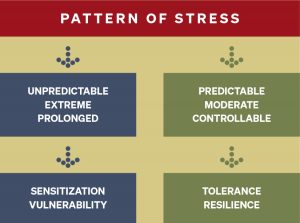CORONAVIRUS (COVID-19) AND SCSBC’S RESPONSE: Find the lastest updates here for students, faculty and staff.
CORONAVIRUS (COVID-19) AND SCSBC’S RESPONSE: Find the lastest updates here for students, faculty and staff.
by Jenny Williams, SCSBC Director of Educational Support Services ◊
The social upheaval and global public health crises have made focusing on leadership, staff, and student well-being more urgent than ever before. Stress impacts the way our brains work and influences how we all think, feel, and behave. Focusing on a hopeful and faith-filled perspective, and understanding how stress affects the brain, will help lead us to greater resilience, mental health, well-being, and learning.

Stress is essential for learning and healthy development. When it is predictable, moderate, and controllable, it can lead to resilience. However, when it is prolonged and overbearing, it may lead to physical and emotional exhaustion. When stress is unpredictable, extreme, and prolonged, we may become more sensitized to stress and, therefore, more vulnerable.1
Everyone has experienced stress and adversity during the pandemic, but not all have been impacted equally. Some of the stressors we have experienced include:
Some teachers are starting the school year exhausted because of stress, distress, and unpredictability. When the body’s stress response system is continuously activated, it takes emotional and physical energy, and prolonged stress brings exhaustion.1 A UBC study found a link between teacher burnout and student cortisol levels, a biological indicator of stress.2 Implementing effective self-care plans for teachers will have a positive impact on the students as well.
New research conducted by UBC found that 80.5 percent of teachers reported that their mental health was worse than before the covid-19 pandemic,3 compared with 40.5% of the general population.4 Declines in the mental health of educators were linked to:
Researchers found that there are protective factors that were also at play for educators. These included when educators felt supported within schools by colleagues and administrators and supported by the Ministry of Education and the broader community.
Administrators can support staff well-being by:
A recent study by BC Children’s Hospital showed that two-thirds of BC youth indicated an increase in mild to moderate mental health conditions such as anxiety, depression, lack of coping skills, acute stress, and post-traumatic stress.5
During learning, incoming information in the brain goes through the lower parts of the brain first, then the emotional and relational parts of the brain (fig. 1). When distress sets in, it shuts off access to the cortex where learning takes place, therefore a distressed brain cannot learn. The more systems that are stressed, the easier it is for an individual to become more reactive and more easily overly stimulated, overwhelmed, and dysregulated.6
During heightened anxiety, higher cognitive skills such as executive function skills are compromised. Executive function skills help us focus and pay attention, make good decisions, have flexible thinking, manage emotions, meet challenges, and accomplish goals.
The frontal cortex manages executive functioning skills, including:
In class, this may show up as students not remembering a series of tasks to achieve a goal. They may have difficulty getting started, and they may get so frustrated by little things that they quickly lose emotional control.
When students become dysregulated, they become disengaged with learning. It would be beneficial for all students to have regular regulating and faith-building activities throughout the day to promote successful learning. We are created for belonging and connection, to be seen, known, and cared for. Being regulated and connected will help students and adults access higher cognitive areas necessary for learning. (fig. 2)
Opening the superhighway to learning involves establishing hope, a sense of safety, structure, predictability, self-regulating opportunities, and positive relationships. Students are showing more significant dysregulation than ever, and starting each day with faith-building, regulating, and connecting activities will be critical.
To build a sense of physical safety, emotional safety, and trust, educators can:
To foster a sense of belonging and connection, educators can:
To provide opportunities for students to regulate physically, emotionally, and cognitively, educators can:
Engaging in daily disciplines that build faith and hope, self-regulation skills, caring relationships, and belonging will help develop more resilient and courageous school leaders, educators, and students amid pandemic challenges. May the Lord richly bless you this school year. I trust you will be able to sing that famous hymn, “It is well with my soul,” and that His love will flow through you to touch others within your school community.
1. Perry, B. “Building Resilience in the Return to School & Trauma-Informed Practices.” 2020. The Neurosequential Model Network. Online Presentation.
2. Oberle, E. & Schonert-Reichl, K. (2016). Stress contagion in the classroom? The link between classroom teacher burnout and morning cortisol in elementary school students. Social Science & Medicine. 159. 10.1016/j.socscimed.2016.04.031.
3. Gadermann, A.M., Warren, M.T., Gagné, M., Thomson, K.C., Schonert-Reichl, K.A., Guhn, M., Molyneux, T.M., & Oberle, E. (2021). The impact of the covid-19 pandemic on teacher well-being in British Columbia. Human Early Learning Partnership. http://earlylearning.ubc.ca/
4. Jenkins, E., McAuliffe, C., Hirani, S., Richardson, C., Thomson, K., McGuinness, L., Morris, J., Kousoulis, A., & Gadermann, A. M. (2021). A portrait of the early and differential mental health impacts of the covid-19 pandemic in Canada: Findings from the first wave of a nationally representative cross-sectional survey. Preventive Medicine, 145. https://doi.org/10.1016/j.ypmed.2020.106333
5. Doan, Q. (2021, March 24) Global News. “Study suggests two-thirds of BC kids and youth experiencing pandemic mental health impacts.” Interview by Linda Aylesworth. Global News. https://globalnews.ca/news/7717788/bc-covid-youth-mental-health-study/
6. Perry, B. “Helping Families Manage Stress and Building Resilience in the Return to School During covid-19”. 2020. The Neurosequential Model Network. Online Presentation.